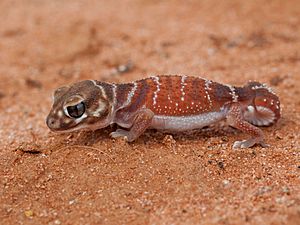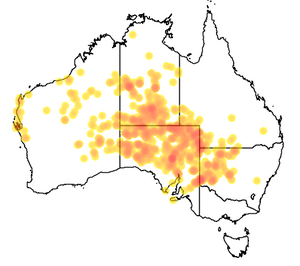Three-lined knob-tailed gecko facts for kids
Quick facts for kids Three-lined knob-tailed gecko |
|
|---|---|
 |
|
| Conservation status | |
| Scientific classification | |
| Genus: |
Nephrurus
|
| Species: |
levis
|
 |
|
| Distribution of recorded occurrences of ''N. levis'' | |
The Nephrurus levis, also known as the three-lined knob-tailed gecko, smooth knob-tailed gecko, or common knob-tailed gecko, is a special gecko from Australia. It's part of the Carphodactylidae family, which are all found only in Australia. People sometimes call this family "barking geckos." This is because they can make loud barks when they feel threatened! When they bark, they might also sway their bodies, curl their tails, and open their mouths.
There are a few different types of Nephrurus levis, like N.l. levis, N.l. occidentalis, and N.l. pibarenis. The Aboriginal name for this gecko is Illchiljera.
Contents
About the Smooth Knob-Tailed Gecko
This gecko is a medium-sized lizard with a strong body. It has a big, triangle-shaped head. Its tail is short and flat, shaped a bit like a carrot, and it ends with a small knob. If a predator tries to catch it, the gecko can drop its whole tail to get away! Unlike some other lizards, it can only drop its tail from one spot, right at the base.
The smooth knob-tailed gecko has long, thin legs with claws that can't be pulled back. The outermost claw on each foot can grab things, like a thumb. It has vertical ear slits on the widest part of its head and very large eyes with pupils that look like vertical slits.
What Does It Look Like?
On its back, this gecko is usually a pinkish-grey to purplish-brown color. It has a unique pattern of darker and lighter spots, lines, or bars. Its belly is white. The gecko's body and tail are covered in small, pale and dark bumps called tubercles, which often form bands. The name "levis" means "smooth," which describes its skin. This is different from another gecko, N. asper, which has rough skin ("asper" means rough).
Most N. levis geckos are about 8 to 10 centimeters (about 3 to 4 inches) long from their snout to where their tail begins. Their original tail, if they haven't dropped it, is usually around 2 centimeters (less than an inch) long. Male geckos are usually smaller than females. Both males and females can live for up to 15 years when cared for by humans.
Where Do These Geckos Live?
Gecko Distribution Across Australia
Smooth knob-tailed geckos live all over the dry, inner parts of Australia. You can find them in every mainland state and territory except Victoria and the ACT. They are very common in South Australia, even as far south as Adelaide. You can also find them far north near Tennant Creek in the Northern Territory, east near Bourke in New South Wales, and west along Western Australia's coast.
Their Natural Homes
These geckos can live in many different kinds of places. They are found in dry areas, semi-dry areas, open woodlands, and dry scrublands. They also live in deserts covered with spinifex grass, sandy plains, and areas with sand dunes.
Gecko Behaviors and Habits
Daily Habits of N. levis
The N. levis gecko is a nocturnal animal, meaning it is active at night. It lives on the ground and hides during the day in burrows. It can dig its own burrows or use burrows made by other animals. It can even seal its burrow entrance! At night, especially after rain, it hunts for food in open areas between bushes or spinifex grass.
These geckos can handle colder temperatures better and for longer than other geckos in their region. This gives them an advantage when hunting at night. They can move faster than their prey, which might be slowed down by the cold. However, on very cold nights, smooth knob-tailed geckos will stay safe in their burrows.
What Do They Eat?
The smooth knob-tailed gecko is an insectivore, which means it mainly eats insects. Their diet includes spiders, grasshoppers, beetles, cockroaches, scorpions, and centipedes. Sometimes, they even eat other smaller geckos!
Reproduction and Life Cycle
The breeding season for these geckos is during the warmer months, from October to March. Female geckos can lay 6 or 7 groups of eggs during this time. When a female is ready to breed, she will show signs that allow males to mate with her. If a female is not ready, she will stand her ground, attack, or run away from the male.
After mating, it takes about 4 to 6 weeks for the female to lay her eggs, though it can sometimes take up to 9 weeks. Once the eggs are laid, they usually hatch in about 6 to 8 weeks. Most of the time, each group of eggs (called a clutch) has 2 eggs, but sometimes there is only one.
Conservation Status
The N. levis gecko is listed as ‘Least Concern’ by the IUCN Red List. This means that scientists are not very worried about this species right now. It lives in a very large area, and there aren't many big threats to it. Some local threats include livestock grazing and land clearing. However, unless there is a huge drop in their numbers, there is no need to put them in a higher threat category.
Images for kids








